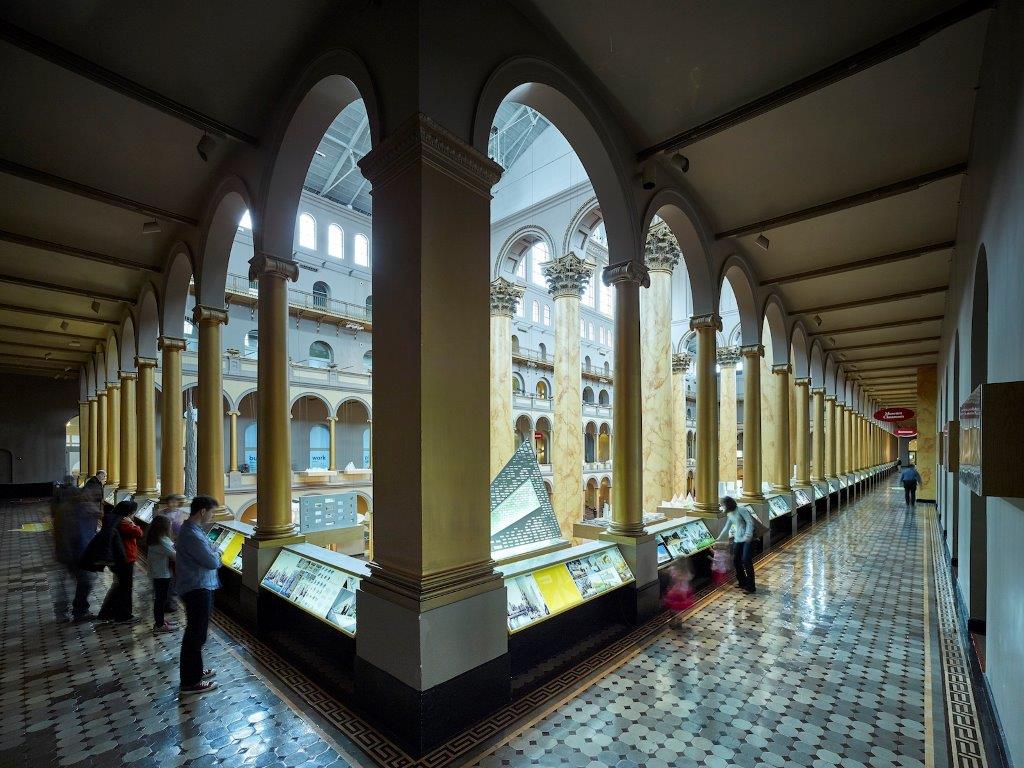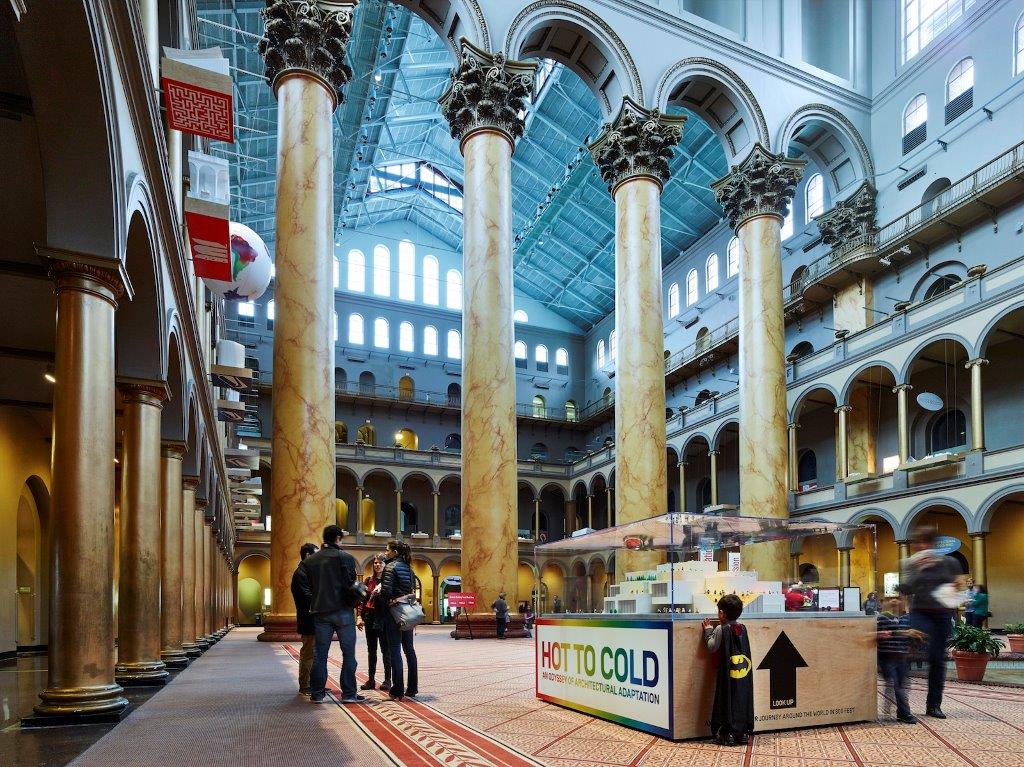On the heels of the summer blockbuster BIG Maze, which attracted more than 50,000 visitors, BIG returns to the National Building Museum with a behind-the-scenes look at the studio’s creative process. The exhibition, Hot to Cold: An Odyssey of Architectural Adaptation, travels from the hottest to the coldest parts of our planet and explores how BIG´s designs are shaped by their cultural and climatic contexts. More than 60 architectural models, mock-ups and prototypes are suspended at the second-floor balconies of the museum’s historic Great Hall, turning the architecture of the National Building Museum into the architecture of the exhibition.
As the visitors move through the exhibition, they learn about the harsh demands of climatic extremes, where architecture becomes more about shading from the heat or sheltering from the cold. The milder or more temperate environments often leave more room for other factors, such as culture, program, politics and legislation to shape the buildings.

"Architecture never happens in the clinical conditions of a lab. It is always responding to a series of existing conditions – the context, the culture, the landscape, the climate. Our climate is the one thing we can’t escape – the one condition we always have to respond to. Hot to Cold is conceived as a colorful exploration of how architecture evolves in response to its context and climate and as an artistic contemplation of how life in return reacts to the framework created by the architecture. I can’t imagine a greater venue than the National Building Museum for this journey, looking back at our work and massive transformation over the last six years from both sides of the Atlantic”, says Bjarke Ingels, Founding Partner, BIG.
Hot to Cold encompasses 60 of BIG’s recent projects of which 20 are premiered for the first time, captured by Iwan Baan´s masterful photography. The exhibition also features films that describe life as it occurs within and around BIG’s buildings in a gallery on the museum’s second floor. Films by Ila Bêka and Louise Lemoine, Kaspar Astrup Schroder, WAAITT and Squint/Opera document the life that emerges once the cranes have left and the buildings are complete. The accompanying catalog by Taschen is designed in collaboration with Grammy Award-winning graphic artist Stefan Sagmeister and is available now at the National Building Museum Shop in-person and online, as well as for preorder on Amazon.
Curator Susan Piedmont-Palladino says that BIG extended its singular design sensibility to the creation of this exhibition: “What’s so special about Hot to Cold is that BIG has perceived the National Building Museum more as a site for a project, rather than as a venue for an exhibition. That means that the sunlight, the sounds, and the sights of the Great Hall will all be part of the context of the display, just as they are for a building in the city. BIG has a very distinctive voice, and our visitors will have a very direct experience, as if the architect is talking, telling stories directly to them.”

Related Stories
Architects | Sep 1, 2017
5 reasons why AEC firms need to focus on employer branding
Not to be confused with the branding of your firm overall, your employer brand is defined by your reputation as a workplace.
Healthcare Facilities | Sep 1, 2017
Caring for caregivers
Many healthcare organizations are increasingly focused on designing amenities, policies, and workplaces to better support their clinicians, health providers, and administrators.
Architects | Aug 31, 2017
How Instagram is changing the design industry
The digital and physical worlds are colliding. How will social media platforms influence the way we design spaces?
Mixed-Use | Aug 30, 2017
A 50-acre waterfront redevelopment gets under way in Tampa
Nine architects, three interior designers, and nine contractors are involved in this $3 billion project.
AEC Tech | Aug 25, 2017
Software cornucopia: Jacksonville Jaguars’ new practice facility showcases the power of computational design
The project team employed Revit, Rhino, Grasshopper, Kangaroo, and a host of other software applications to design and build this uber-complex sports and entertainment facility.
Multifamily Housing | Aug 24, 2017
Storage units, lounges most popular indoor and outdoor amenities in multifamily developments
Tenants and condo owners crave extra space for their stuff. Most developers are happy to oblige.
Green | Aug 24, 2017
Business case for WELL still developing after first generation office fitouts completed
The costs ranged from 50 cents to $4 per sf, according to a ULI report.
Healthcare Facilities | Aug 24, 2017
7 design elements for creating timeless pediatric health environments
A recently published report by Shepley Bulfinch presents pediatric healthcare environments as “incubators for hospital design innovation.”
BD+C University Course | Aug 23, 2017
AIA course: New steel systems add strength and beauty
Advances in R&D are fostering new forms of structural and aesthetic steel.
Market Data | Aug 23, 2017
Architecture Billings Index growth moderates
“The July figures show the continuation of healthy trends in the construction sector of our economy,” said AIA Chief Economist, Kermit Baker.

















